Philodendron joepii is a super rare, much sought, pricey, and one of the most exotic houseplants. Mature plants have oddly-shaped three lobed green leaves, i.e., the lower lobe is wide and tapers upward, having a narrow body, while the upper, outward pointed lobes are slender.
What better way to make a statement and create a tropical backdrop than buying this unique plant believed to be a hybrid? It is easy to care for and purifies the air. Just ensure you grow it in a warm, humid area with bright, indirect light. But there are other requirements like soil, watering, pruning, feeding, etc.
Discover more about Philodendron joepii, including origin and history, care needs, and issues or problems. We will also tell you where to buy it, Etsy.com and eBay being the best, prices, and how it differs from Philodendron 69686 and P. moonenii.
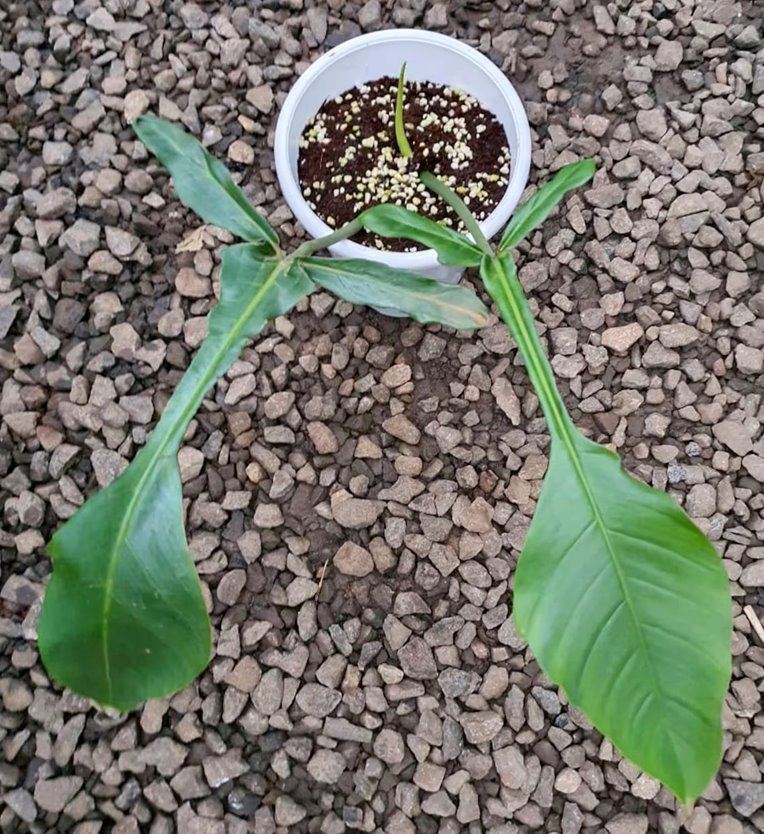
Contents
- Quick overview
- History and origin
- Description and identification
- Philodendron joepii variegated
- P. joepii tissue culture (TC)
- Philodendron joepii vs. 69686
- Philodendron joepii vs. moonenii
- Philodendron joepii care and growth requirements
- Philodendron joepii propagation
- Issues and problems
- 1. Root rot
- 2. Pests
- 3. Diseases
- 4. Leaf discoloration
- 5. Plant drooping and leaves curling
- Where to buy Philodendron joepii – eBay, Etsy.com
- Frequently asked questions (FAQs)
Quick overview
- Scientific name: None (unpublished or undescribed)
- Common names: Philodendron ‘joepii’
- Family: Araceae (aroid or arum family)
- Natural habitat: French Guiana
- Toxicity: This Philodendron is toxic or harmful to dogs, cats, and humans since its sap has insoluble calcium oxalates. These sharp crystals will cause severe oral irritation and a burning sensation. Also, the mouth, tongue, and lips may turn red and swell. More signs include drooling, swallowing difficulties, and loss of appetite
- Care level: Low maintenance or easy.
History and origin
Philodendron joepii, pronounced as yupe-E-eye, is a rare, most likely a natural hybrid. Dr. Joep Moonen, a Dutch naturalist, first collected this plant in 1991 at Mataroni River, eastern French Guiana, growing on a nest of ants.
Its odd, tri-lobed leaves made him think that perhaps insects had munched it or were malformed. However, that was not the case.
While the exact parentage is unknown, Dr. Joep Moonen believed it might be a hybrid of Philodendron bipennifolium and Philodendron pedatum. These two plants grew near where he collected P. joepii. Also, its ear-like lobes and inflorescence resemble P. pedatum.
Most people often confuse P. joepii with Philodendron 69686, but these two are different plants. Also, some people incorrectly label it as Philodendron moonenii.
Lastly, it is worth noting that this plant is extremely rare or almost extinct. Only two plants are known in their natural habitat.
Description and identification
Philodendron joepii is an evergreen climbing hemiepiphyte native to French Guiana. A hemiepiphyte is a plant that has ground (terrestrial) and epiphytic (on trees) growth phases.
Like most Philodendron plants, this tropical rainforest plant morphs. So, you expect the seedling, juvenile, and mature plants to look different, i.e., the leaf changes its shape and size.
Seedlings or baby plants will have lance-shaped to oblanceolate (reversed lance-shaped) green leaves. The plant will start putting on leaves with small rounded lobes as they grow into juvenile and subadults.
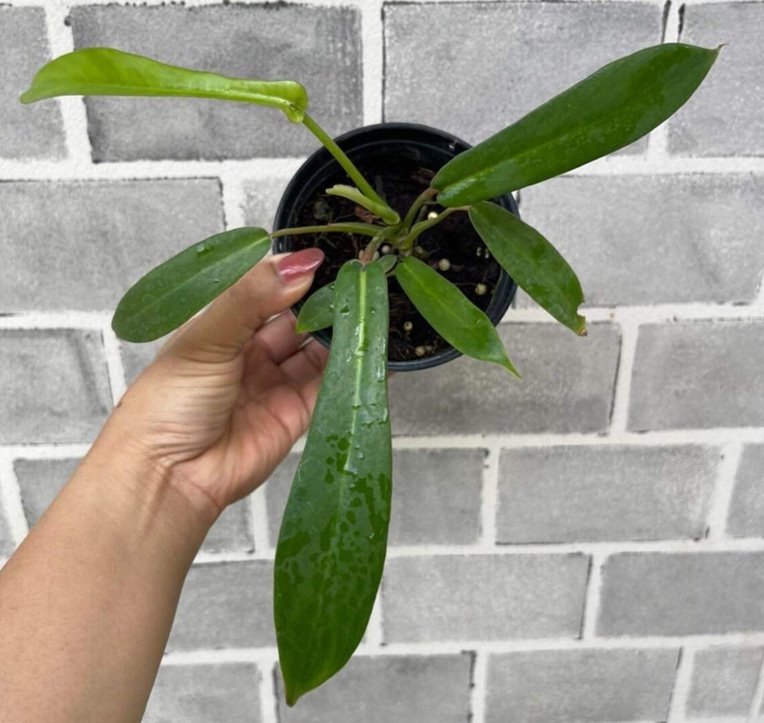
Mature Philodendron joepii will have large (about 27.5 inches long), three-lobed green leaves. These uniquely shaped leaves have a wider lower lobe that tapers upwards, and its body becomes slender and two slender ear-like upward and outward growing posterior lobes. These upper lobes emerge at roughly 45 degrees.
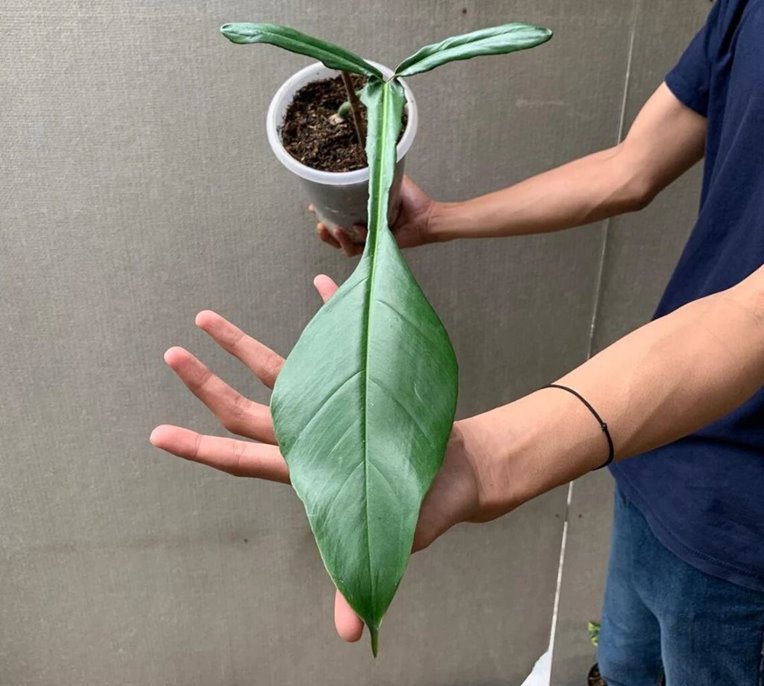
Also, the edges become ragged, especially from where it starts tapering and on the upper lobes.
Mature plants will have inflorescence flowers borne on a spadix with a surrounding spathe (bract). The spadix will then have infructescences (aggregated fruits).
However, there hasn’t been much success in having fruits under cultivation as the spathe prematurely falls.
Lastly, Philodendron joepii has a relatively slow growth rate, and you need to give it a place to climb if you want it to grow mature leaves
Philodendron joepii variegated
We cannot rule out the existence of a variegated Philodendron joepii but acknowledge that it is super rare. Such variegation will be chimeral and, to be specific, sectorial, and it occurs in one in about 100,000 plants. Remember, these plants are already rare.
We have only seen one vendor with a slightly variegated P. joepii, i.e., with cream or yellowish markings at eBay. It is selling for GBP 2,000.00 (US $2,470.50). However, we cannot comment on if it is genuinely variegated. We expected prices to be much higher.
P. joepii tissue culture (TC)
Tissue culture or micropropagation is a method of propagating or cloning plants using a small part, a few cells, or a single cell. It happens in sterilized conditions with the required growth nutrients and hormones.
Resultant plants have their pros and cons, and people have different opinions. Some prefer them while others don’t.
There are indeed Philodendron joepii tissue culture (TC) plants in the market. So, we recommend that you inquire from your vendor if they are TC or not.
Philodendron joepii vs. 69686
Both these plants are possibly Philodendron natural hybrids and have tri-lobed mature leaves. Some people even confuse them. However, they do have apparent differences.
Philodendron 69686 has slightly rounded lobes with the upper ones resembling bunny ears. The lower lobe isn’t conspicuously broader and doesn’t taper upwards to having a narrow body like P. joepii. Also, the upper lobes are not as slender.
Philodendron joepii vs. moonenii
Some people mislabel or claim P. joepii is the same plant as Philodendron moonenii. However, this shouldn’t be the case since P. moonenii is oval leafed and not the oddly shaped tri-lobed leaf blades that P. joepii has.
Philodendron joepii care and growth requirements
Philodendron joepii grows best in a warm (65-85°F), humid area with bright indirect light. The soil should be airy, well-drained, and fertile, and you should water it when the top few inches of the potting mix feel dry.
Here is how to care for P. joepii and growth requirements.
- USDA hardiness zone: 10-11, not frost tolerant.
- Temperature: 65-85°F (18-29°C). Avoid temperatures below 50°F, cold drafts, and sudden changes. Also, don’t place your plant near heat sources.
- Humidity: Loves high humidity, 60% plus but can tolerate moderate (40-50%). Mist these plants, have a pebble tray or buy a humidifier if your humidity is too low.
- Light needs: Bright, indirect light but can still grow in the medium. Avoid direct sun (except early morning) and invest in grow lights if your light is insufficient.
- Soil mix: P. joepii requires a well-draining, aerated potting mix rich in organic matter. Buy an aroid mix (See Etsy.com) or make one by adding peat moss, pearlite, bark chips, and compost to your potting soil to make one.
- Watering: Thoroughly water this aroid when the top few inches feel dry (up to 1st knuckle of your finger) or when your soil moisture sensor reads dry. We use XLUX Soil Moisture Meter, but Sonkir and Gouevn are also good.
- Fertilizer: Feed your plant monthly during the growing season with an all-purpose, houseplant liquid fertilizer at half recommended strength. A slow-release fertilizer for potted houseplants. Something like Bonide Liquid Plant Food 10-10-10 is ok.
- Pruning: Snip dead, damaged, or diseased parts or leaves with sterilized gardening shears. Also, you can rim a few stems to control size or growth in early spring.
- Repotting: Repot after 2-3 years or if rootbound. Use a pot 2-3 inches wider in diameter.
- Support: Give and guide your plant on a moss pole, trellis, totem, or any other stake.
Philodendron joepii propagation
Philodendron joepii propagation is by stem cutting (in water or soil) and air layering. You can propagate your plant at any time. But doing so during growing months will make the process faster.
To use the stem cutting method, you need a stem with at least a node (the knobby part where leaves attach and aerial roots grow). The rest of the steps are similar to how you propagate any climbing Philodendron plant.
On the other hand, air layering entails wrapping moist sphagnum moss on a node while the stem is still attached to the mother plant. Keep the moss aerated and moist. After some time, roots will grow, and when long enough, you will cut the stem and plant it.
Issues and problems
If you grow this aroid in ideal conditions and provide the necessary care, issues will be uncommon. However, like other Philodendron plants, you may have a few problems, common ones being:
1. Root rot
Root rot is the most commonly reported issue to people who overwater, use oversized pots, or whose potting mix doesn’t drain.
Signs include yellow leaves, mushy stem bases, stunted growth, and wilting (which doesn’t improve with watering). And if you check the roots, they will be mushy black or brown.
Repotting is the sure way to save your plant if not all the root ball has decayed. While repotting, cut any decayed portions with sterilized gardening shears.
2. Pests
Pests don’t present a significant threat if you grow your plant indoors. But they may have scale insects, thrips, mealybugs, mites, and aphids.
Signs are specific to the bug your plant has. Generalized ones include webbing, honeydew, sooty mold, silvery stippling, spots (brown, black, whitish, or yellow), etc. Only under heavy infestation can you see distorted, curly, or deformed leaves that may look pinched or cupped.
Check with your 10X magnifying glass and if you see any bugs, use insecticidal soaps or neem oil. Also, horticultural spray oils will work.
3. Diseases
Yes, these plants are susceptible to fungal and bacterial leaf spots and blights that affect other Philodendron species. But if you isolate new plants and practice proper sanitation, your plants won’t have them.
Therefore, wash your hands before touching your plants and sterilize gardening tools.
4. Leaf discoloration
Aging can make a few lower leaves turn yellow and brown. Other causes relate to care, growing conditions, pests, and disease.
For example, the yellowing of leaves is often a sign of overwatering. But other things like too much or little light, heat stress, and cold drafts may be reasons. Even rare reasons like nutritional deficiency may be to blame.
Brown tips and edges indicate underwatering, low humidity, heat stress, fertilizer burns, and too much light. Also, anything that causes quick moisture loss or prevents water absorption may be a reason, including root rot.
It may be overwatering if you see brown or black splotches, while overnight browning indicates cold drafts or damage.
Lastly, transplant shock or rootbound plants may also show leaf discolorations, including yellowing, browning, brown tips, and edges.
5. Plant drooping and leaves curling
Joepii leaves curling is a means to prevent moisture loss, while this plant drooping means cells are flaccid, i.e., they don’t have enough water to keep them turgid.
Reasons for both these issues are underwatering, low humidity, too much light, and heat stress. Also, anything that hampers water absorption or increases moisture loss from leaves is a possible cause.
Where to buy Philodendron joepii – eBay, Etsy.com
The best place to buy Philodendron joepii is Etsy.com and eBay. These marketplaces have sellers from the US, the UK, Canada, Australia, Malaysia, Singapore, Thailand, Germany, etc. Some are willing to ship worldwide. Also, their prices are unbeatable.
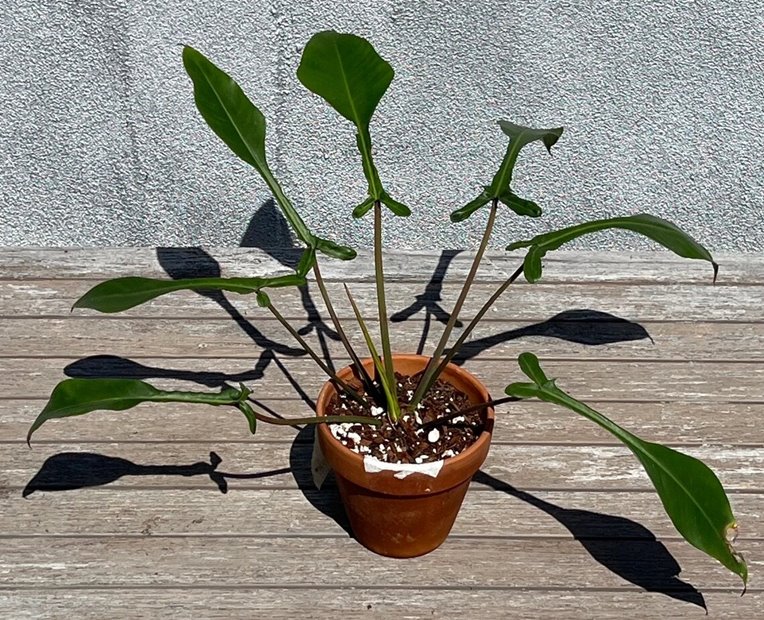
Facebook and Instagram are the other places to hunt for this rare houseplant. Like Etsy and eBay, you will find vendors across the globe.
More places buy this charming and rare plant, and their respective prices include the following:
The US
- Peace Love and Happiness Club (Seattle, WA) -$1,888.00
- Vedas Plant Shop (Chicago, IL) - $800.00
- Frog Daddy Bessemer City, NC $499.99 Sold out
- Plant Mutha Luvas (Street Oakland, CA) $8000
- Black Jungle Exotics (Greenfield, MA) $1,495.00
- Ecuagenera USA (Apopka, FL) -$450
- OrchidBox (Dallas, TX) $172.00 USD
Europe and UK
- The Rare Plant Shop (Burnley, UK) - £ 350.00
- Claessen Orchids (Nederweert-Eind, Netherlands) - €449.95
Asia
- BOTGarden (Thanh Hoa, Vietnam) $165.00 – $450.00 (Tissue Culture)
- RAV House (Jawa Barat, Indonesia) –$939.99
- Shopee (Kuala Lumpur, Malaysia) -RM6,500.00
- Carrousel (Manila, Philippines) - PHP 520,000
Didn’t you find this plant? Search “Philodendron joepii for sale” to get more locations. You won’t fail to get one near you.
Frequently asked questions (FAQs)
Yes. Philodendron joepii is a super rare, pricey, and hard-to-find houseplant. Only a few rare plant collectors and sellers have it. You will not find it at your local tropical specialty stores, and none of the big horticultural companies have it.
Philodendron joepii price ranges from $150 to $2,500, depending on the size and where you buy it. Small, including tissue culture plants with baby leaves, may cost you between $150 and $400, while larger plants with subadult or adult leaves will cost more than $400.
Also, the prices change with location. For instance, in the Philippines, Philodendron joepii price is PHP 520,000 (USD9,945).
Philodendron joepii is so expensive because it is rare (only two known in the wild) and in high demand or much sought after by everyone. Also, this charmingly adorable plant grows slowly, meaning producing or propagating large volumes will take a long. So, collectors don’t mind paying more to have it.
However, with the increase in the availability of Philodendron joepii tissue culture plants, plants may go down for those who don’t mind them.
You may have seen people selling P. joepii seedlings, which may make you wonder whether there are seeds. The answer is no. There are no P. joepii seeds on sale, and the seedlings sold are either from cuttings or tissue cultured plants.

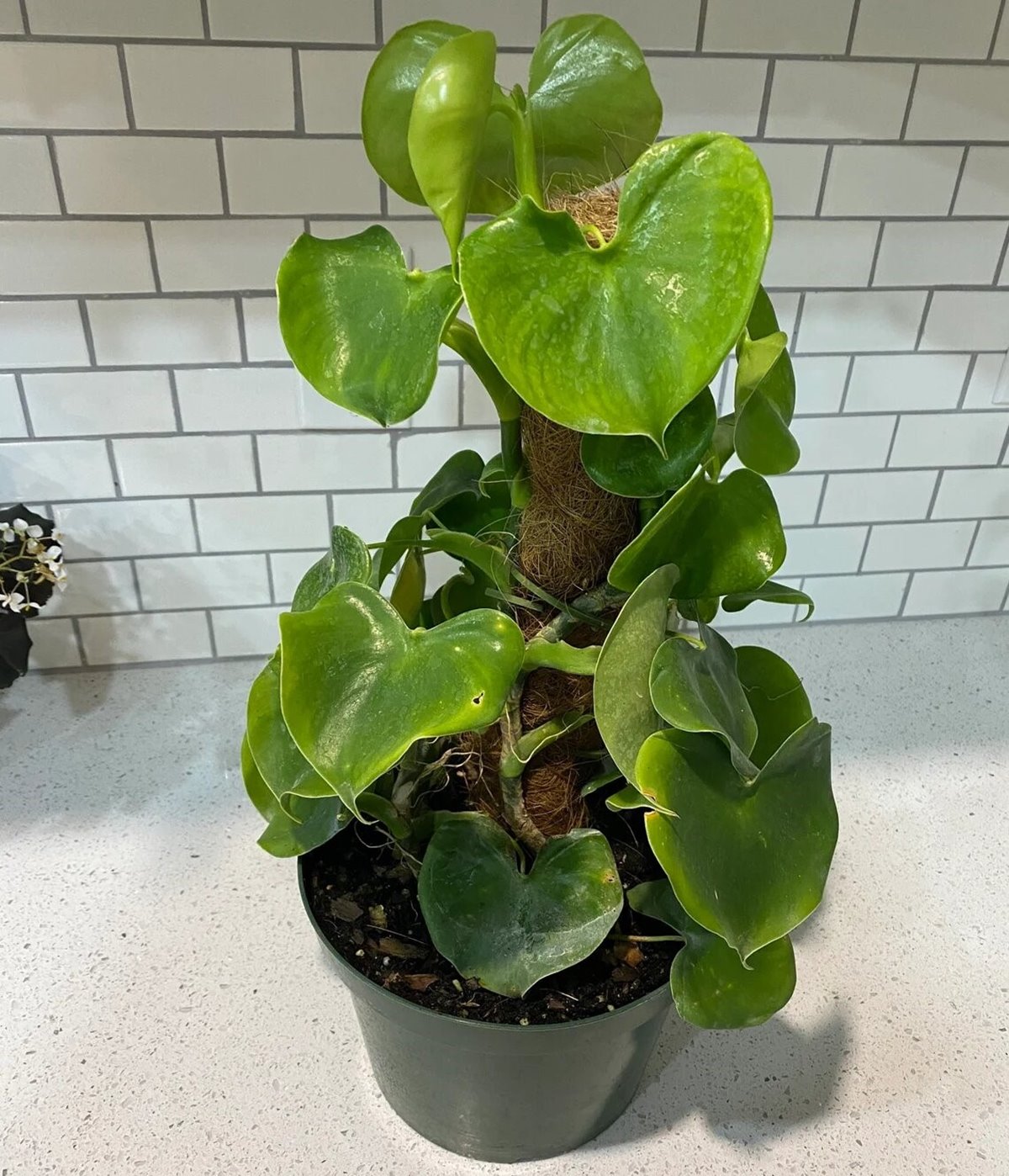
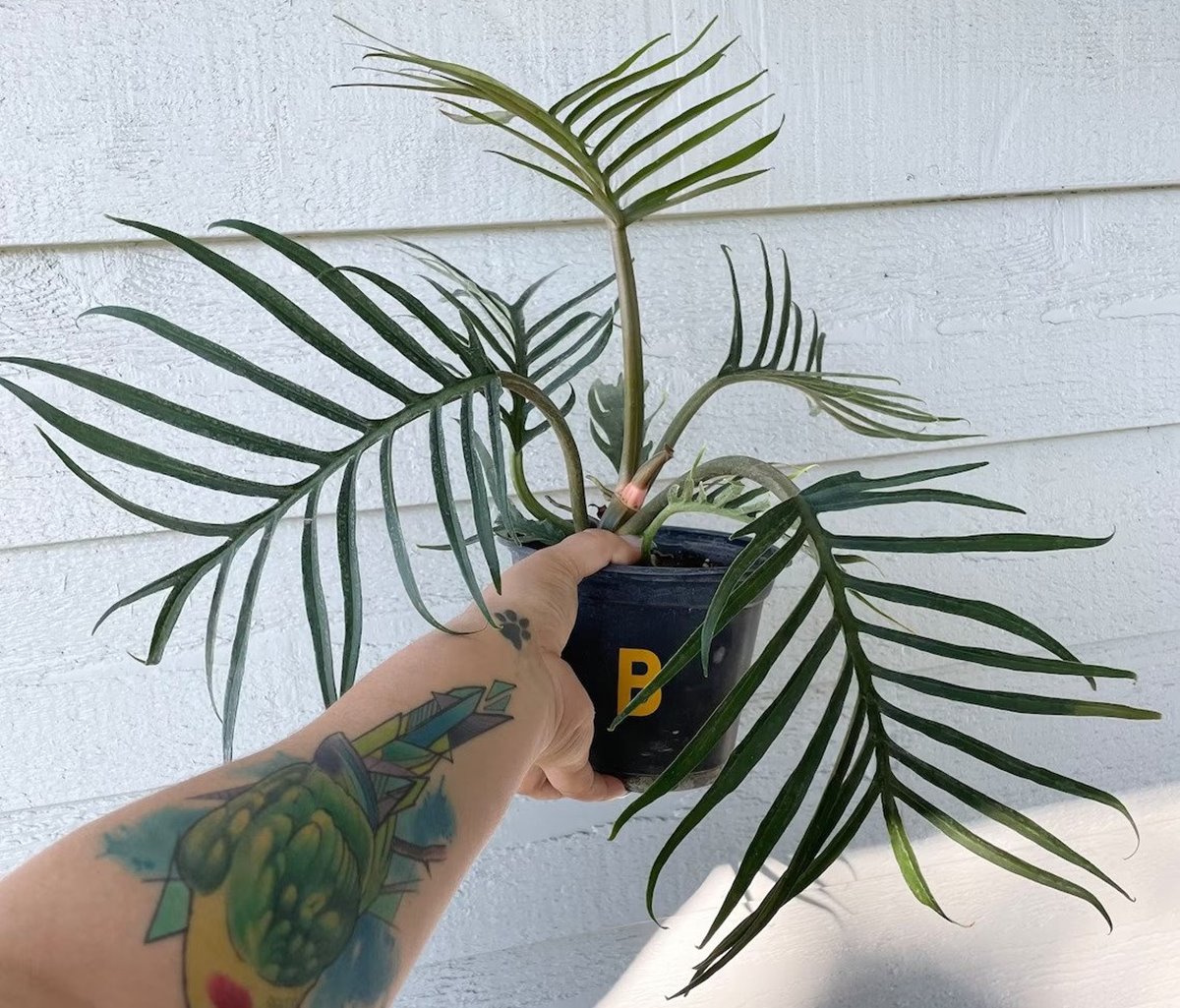
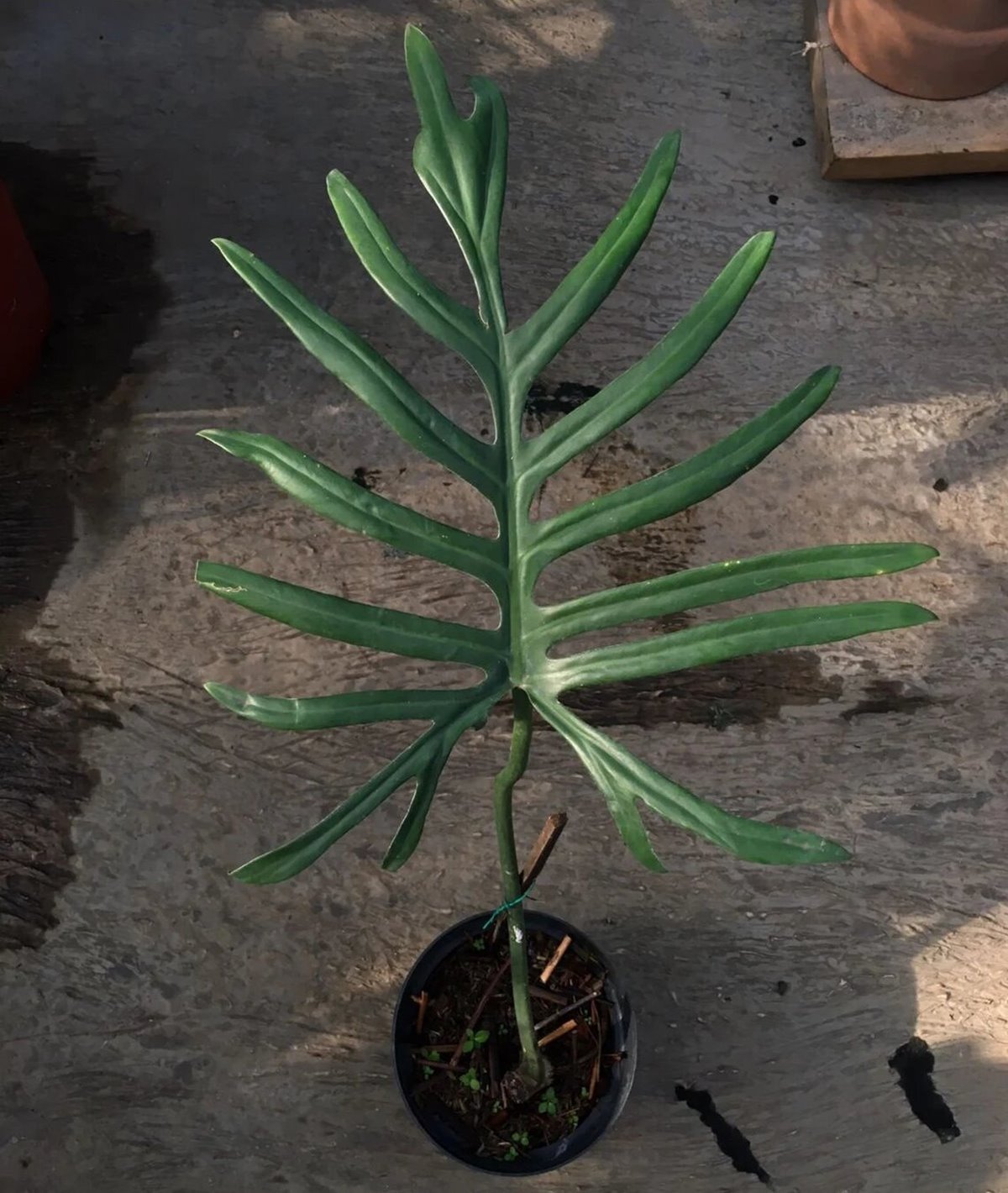

Leave a Reply